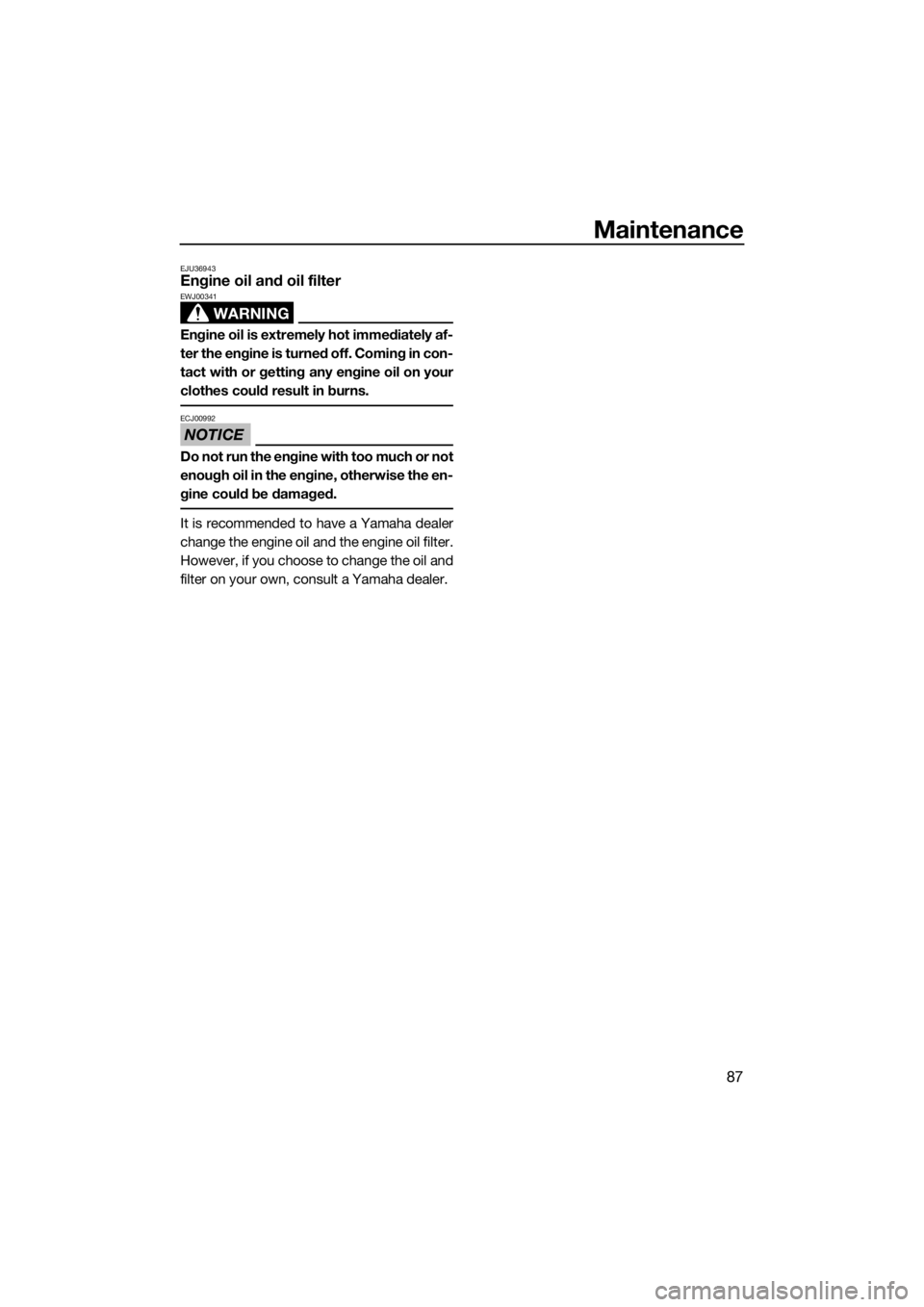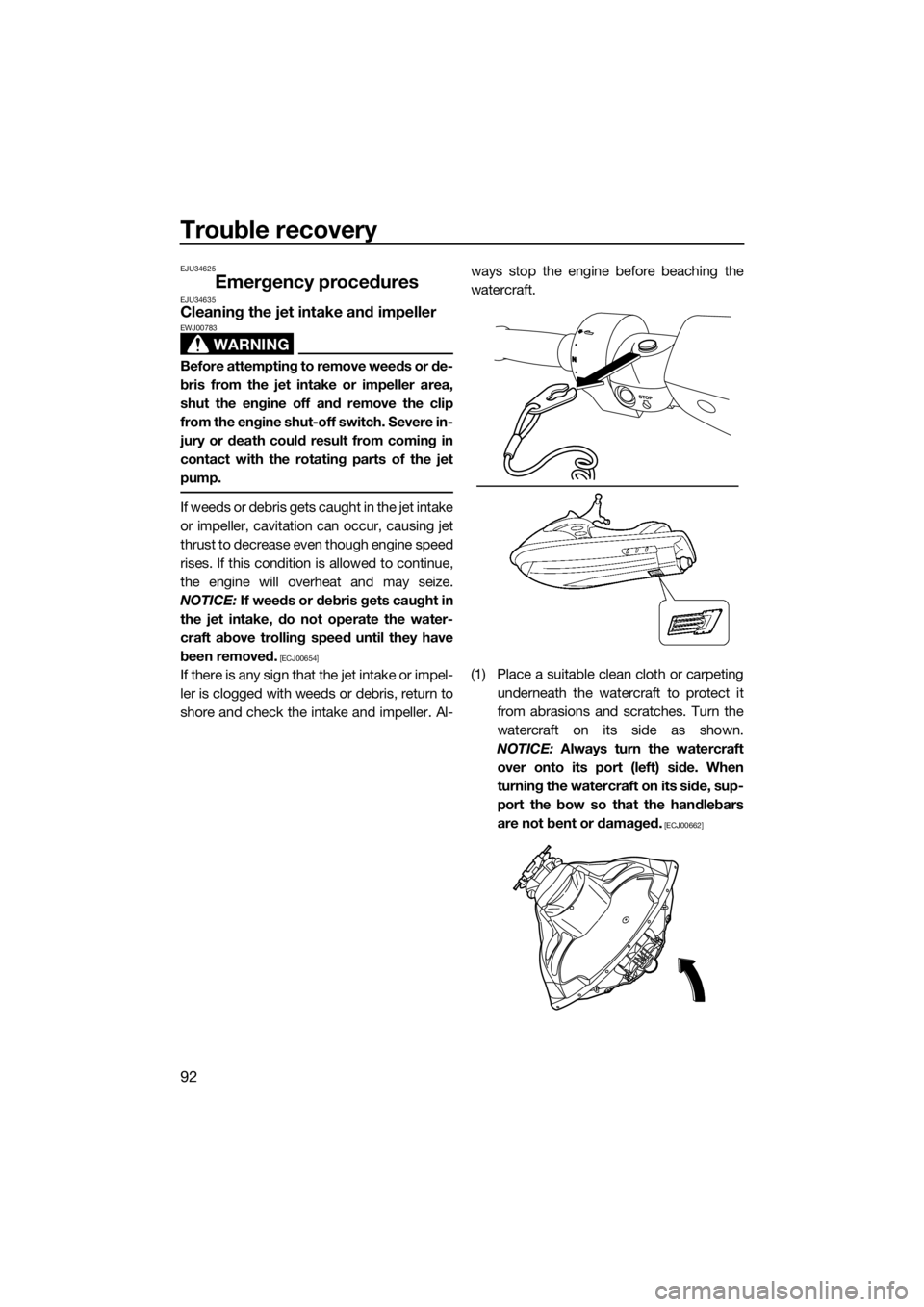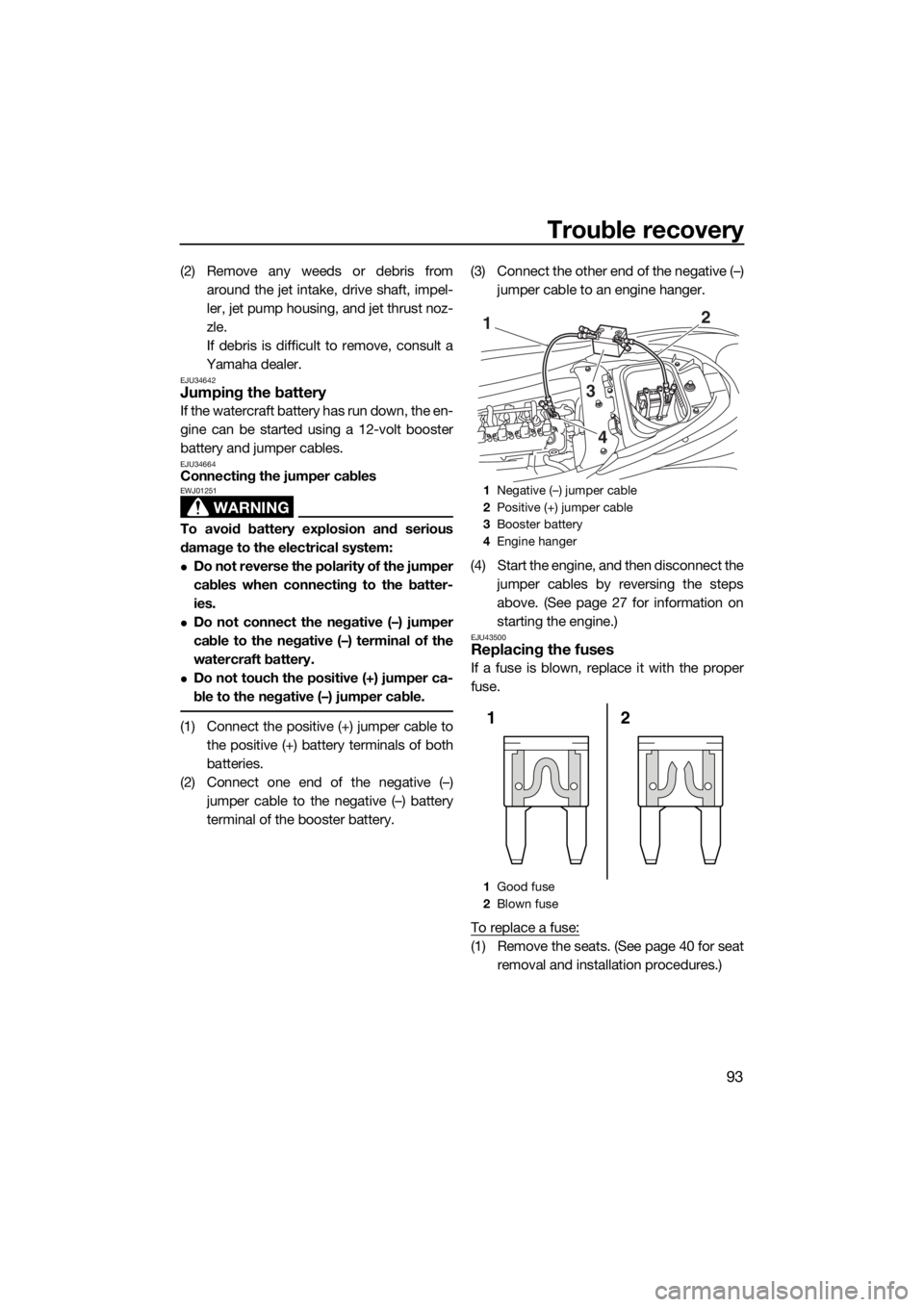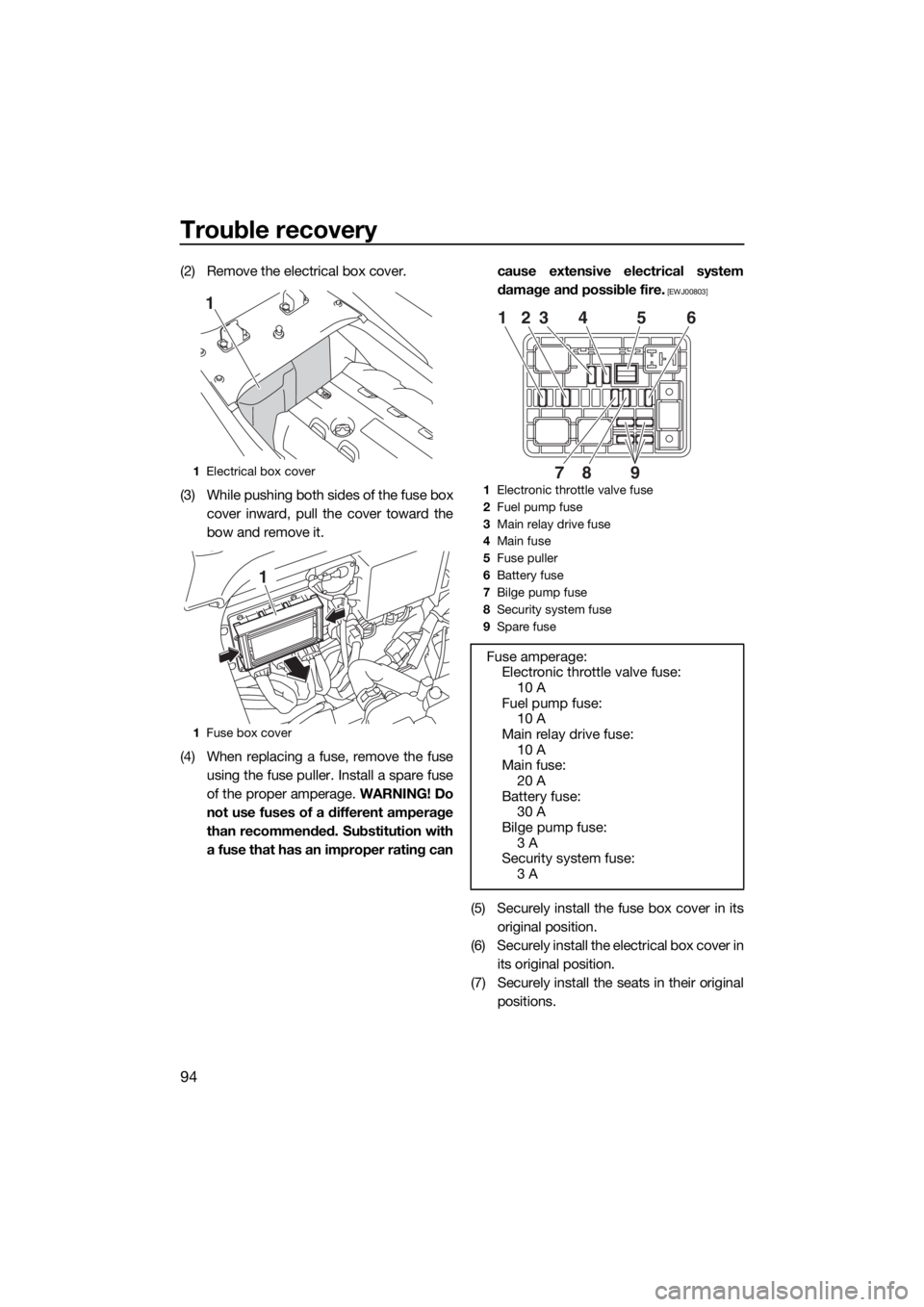YAMAHA FZR 2015 Owners Manual
Manufacturer: YAMAHA, Model Year: 2015, Model line: FZR, Model: YAMAHA FZR 2015Pages: 104, PDF Size: 4.29 MB
Page 91 of 104

Maintenance
85
EJU43101Periodic maintenance chart
The periodic maintenance chart gives general guidelines for periodic maintenance. Have a
Yamaha dealer perform the checks in the following chart. However, maintenance may need
to be performed more frequently depending on your operating conditions. If you have any
questions, consult a Yamaha dealer.
This “√” mark indicates items to be checked and serviced by a Yamaha dealer.
Item OperationInitial Thereafter every
Page
10 hours50 hours
or 12
months
*1100
hours or
12
months
*1200
hours or
24
months
*1
Fuel lineCheck fuel hoses and
clamps√—
Fuel filler cap/Wa-
ter separatorCheck O-rings for cracks
and deformation√—
Fuel tankCheck installation and
straps√—
Water inlet strainerCheck for clogs and dam-
age√—
Cooling water hos-
esCheck for damage and
leakage, and check
clamps√—
Engine oilReplace√√87
Oil filterReplace√87
Intermediate hous-
ingLubricate√—
Spark plugsCheck√√—
BatteryCheck specific gravity of
electrolyte, terminals,
bands, and breather hose√—
Battery leadsCheck terminals√—
Steering masterCheck operation and for
looseness√√—
Steering cableCheck exterior and con-
nections, and lubricate√—
Q.S.T.S. cableCheck exterior and con-
nections, and lubricate√—
Q.S.T.S. converter
and rodCheck exterior and con-
nections, and lubricate√√—
Shift leverCheck exterior and con-
nections, and lubricate√—
Shift cable and re-
verse gateCheck exterior and con-
nections, and lubricate
√—
UF3L71E0.book Page 85 Monday, June 30, 2014 9:06 AM
Page 92 of 104

Maintenance
86
*1: Whichever comes first.
*2: Check every 200 hours.
Perform the pre-operation checks and post-operation checks before performing periodic
maintenance.
Air filter elementCheck for damage and
dirt√—
Air intake hosesCheck for damage, and
check clamps√—
Throttle bodyLubricate throttle valves√—
Exhaust systemCheck for exhaust leak-
age, and check hoses and
clamps√—
Breather hoseCheck breather hose and
clamps√—
ImpellerCheck for bends, dam-
age, and foreign material√—
Jet thrust nozzleCheck movement, and lu-
bricate√—
Jet vacuum bilgeCheck hoses for clogs
and damage, check
clamps, and clean bilge
strainer√—
Electric bilge pumpCheck operation, check
hoses for damage, check
clamps, and clean bilge
pump strainer√—
Stern drain plugsCheck O-rings√—
AnodeCheck for corrosion, and
clean√ *2 —
Valve clearanceCheck and adjust√ *2 —
Rubber couplingCheck for cracks, inden-
tations, looseness, and
noise√—
Engine mountCheck for damage and
peeling√— Item OperationInitial Thereafter every
Page
10 hours50 hours
or 12
months
*1100
hours or
12
months
*1200
hours or
24
months
*1
UF3L71E0.book Page 86 Monday, June 30, 2014 9:06 AM
Page 93 of 104

Maintenance
87
EJU36943Engine oil and oil filter
WARNING
EWJ00341
Engine oil is extremely hot immediately af-
ter the engine is turned off. Coming in con-
tact with or getting any engine oil on your
clothes could result in burns.
NOTICE
ECJ00992
Do not run the engine with too much or not
enough oil in the engine, otherwise the en-
gine could be damaged.
It is recommended to have a Yamaha dealer
change the engine oil and the engine oil filter.
However, if you choose to change the oil and
filter on your own, consult a Yamaha dealer.
UF3L71E0.book Page 87 Monday, June 30, 2014 9:06 AM
Page 94 of 104

Specifications
88
EJU34543
Specifications
Watercraft capacity:
Maximum people on board:
2 person
Maximum load capacity:
160 kg (353 lb)
Dimensions:
Length:
3370 mm (132.7 in)
Width:
1230 mm (48.4 in)
Height:
1160 mm (45.7 in)
Dry weight:
359 kg (791 lb)
Performance:
Maximum output (according to ISO 8665/SAE
J1228):
183.9 kW@7500 r/min
Maximum fuel consumption:
77.7 L/h (20.5 US gal/h, 17.1 Imp.gal/h)
Cruising range at full throttle:
0.90 hour
Trolling speed:
1250 ±100 r/min
Engine:
Engine type:
Liquid cooled 4-stroke, DOHC
Number of cylinders:
4
Engine displacement:
1812 cm³
Bore × stroke:
86.0 × 78.0 mm (3.39 × 3.07 in)
Compression ratio:
8.5 : 1
Valve clearance-intake (cold):
0.14–0.23 mm (0.0055–0.0091 in)
Valve clearance-exhaust (cold):
0.36–0.45 mm (0.0142–0.0177 in)
Lubrication system:
Wet sump
Cooling system:
Water
Starting system:
Electric
Ignition system:
T.C.I.Spark plug:
LFR7A
Spark plug gap:
0.8–0.9 mm (0.031–0.035 in)
Battery capacity:
12 V, 19 Ah
Charging system:
Flywheel magneto
Drive unit:
Propulsion system:
Jet pump
Jet pump type:
Axial flow, single stage
Impeller rotation:
Counterclockwise
Jet thrust nozzle angle:
24.0+24.0 °
Jet thrust nozzle trim angle:
-10, -5, 0, 5, 10 °
Fuel and oil:
Recommended fuel:
Premium unleaded gasoline
Minimum octane rating (PON):
91
Minimum octane rating (RON):
95
Recommended engine oil type SAE:
SAE 10W-30, 10W-40, 20W-40, 20W-50
Recommended engine oil grade API:
API SE,SF,SG,SH,SJ,SL
Fuel tank total capacity:
70 L (18.5 US gal, 15.4 Imp.gal)
Engine oil quantity with oil filter replacement:
3.6 L (3.81 US qt, 3.17 Imp.qt)
Engine oil quantity without oil filter replacement:
3.5 L (3.70 US qt, 3.08 Imp.qt)
Engine oil total quantity:
5.3 L (5.60 US qt, 4.66 Imp.qt)
UF3L71E0.book Page 88 Monday, June 30, 2014 9:06 AM
Page 95 of 104

Trouble recovery
89
EJU34562
Troubleshooting
If you have any trouble with your watercraft, use the troubleshooting chart to check for the
possible cause.
If you cannot find the cause, consult a Yamaha dealer.
EJU36986Troubleshooting chart
Confirm the possible cause and remedy, and then refer to the applicable page.
TROUBLE POSSIBLE CAUSE REMEDY PAGE
Engine does not
start (Starter motor
does not turn over)Ya m a h a S e -
curity SystemLock mode selected Select unlock mode
26
Engine shut-
off switchClip not in place Install clip
27
Fuse Burned out Replace fuse and
check wiring93
Battery Run down Recharge 78
Poor terminal con-
nectionsTighten as required
78
Terminal corroded Clean or replace 78
Starter motor Faulty Have serviced by
Yamaha dealer—
Engine does not
start (Starter motor
turns over)Throttle lever Squeezed Release 27
Fuel Fuel tank empty Refill as soon as pos-
sible47
Stale or contaminat-
edHave serviced by
Yamaha dealer—
Fuel tank Water or dirt present Have serviced by
Yamaha dealer—
Spark plug Fouled or defective Have serviced by
Yamaha dealer—
Spark plug
capNot connected or
looseHave serviced by
Yamaha dealer—
Connected to wrong
cylinderHave serviced by
Yamaha dealer—
Fuel injec-
tion systemFuel pump faulty Have serviced by
Yamaha dealer—
UF3L71E0.book Page 89 Monday, June 30, 2014 9:06 AM
Page 96 of 104

Trouble recovery
90
Engine runs irregu-
larly or stallsFuel Fuel tank empty Refill as soon as pos-
sible47
Stale or contaminat-
edHave serviced by
Yamaha dealer—
Incorrect octane
numberUse correct fuel
47
Fuel tank Water or dirt present Have serviced by
Yamaha dealer—
Spark plug Fouled or defective Have serviced by
Yamaha dealer—
Incorrect heat range Have serviced by
Yamaha dealer—
Gap incorrect Have serviced by
Yamaha dealer—
Spark plug
capNot connected or
looseHave serviced by
Yamaha dealer—
Cracked, torn, or
damagedHave serviced by
Yamaha dealer—
Electrical wir-
ingLoose connection Have serviced by
Yamaha dealer—
Fuel injec-
tion systemFaulty or clogged in-
jectorsHave serviced by
Yamaha dealer—
Warning light or in-
dicator blinks or
comes onFuel level
warningFuel tank empty Refill as soon as pos-
sible47
Oil pressure
warningOil pressure dropped Have serviced by
Yamaha dealer37
Engine over-
heat warningJet intake clogged Clean
92
Check en-
gine warningFaulty sensors Have serviced by
Yamaha dealer38 TROUBLE POSSIBLE CAUSE REMEDY PAGE
UF3L71E0.book Page 90 Monday, June 30, 2014 9:06 AM
Page 97 of 104

Trouble recovery
91
Watercraft slow or
loses powerShift lever Not completely shift-
ed into forward posi-
tionPush lever forward
until it stops 31
Watercraft
operation
modeLow RPM Mode acti-
vatedDeactivate Low RPM
Mode 33
Cavitation Jet intake clogged Clean 92
Impeller damaged or
wornHave serviced by
Yamaha dealer92
Engine over-
heat warningEngine speed reduc-
tion control activatedClean jet intake and
cool engine38
Oil pressure
warningEngine speed reduc-
tion control activatedAdd oil
37
Spark plug Fouled or defective Have serviced by
Yamaha dealer—
Incorrect heat range Have serviced by
Yamaha dealer—
Gap incorrect Have serviced by
Yamaha dealer—
Spark plug
capNot connected or
looseHave serviced by
Yamaha dealer—
Electrical wir-
ingLoose connection Have serviced by
Yamaha dealer—
Fuel Stale or contaminat-
edHave serviced by
Yamaha dealer—
Incorrect octane
numberUse correct fuel
47
Air filter Clogged Have serviced by
Yamaha dealer—
Oil buildup Have serviced by
Yamaha dealer— TROUBLE POSSIBLE CAUSE REMEDY PAGE
UF3L71E0.book Page 91 Monday, June 30, 2014 9:06 AM
Page 98 of 104

Trouble recovery
92
EJU34625
Emergency proceduresEJU34635Cleaning the jet intake and impeller
WARNING
EWJ00783
Before attempting to remove weeds or de-
bris from the jet intake or impeller area,
shut the engine off and remove the clip
from the engine shut-off switch. Severe in-
jury or death could result from coming in
contact with the rotating parts of the jet
pump.
If weeds or debris gets caught in the jet intake
or impeller, cavitation can occur, causing jet
thrust to decrease even though engine speed
rises. If this condition is allowed to continue,
the engine will overheat and may seize.
NOTICE: If weeds or debris gets caught in
the jet intake, do not operate the water-
craft above trolling speed until they have
been removed.
[ECJ00654]
If there is any sign that the jet intake or impel-
ler is clogged with weeds or debris, return to
shore and check the intake and impeller. Al-ways stop the engine before beaching the
watercraft.
(1) Place a suitable clean cloth or carpeting
underneath the watercraft to protect it
from abrasions and scratches. Turn the
watercraft on its side as shown.
NOTICE: Always turn the watercraft
over onto its port (left) side. When
turning the watercraft on its side, sup-
port the bow so that the handlebars
are not bent or damaged.
[ECJ00662]
UF3L71E0.book Page 92 Monday, June 30, 2014 9:06 AM
Page 99 of 104

Trouble recovery
93
(2) Remove any weeds or debris from
around the jet intake, drive shaft, impel-
ler, jet pump housing, and jet thrust noz-
zle.
If debris is difficult to remove, consult a
Yamaha dealer.
EJU34642Jumping the battery
If the watercraft battery has run down, the en-
gine can be started using a 12-volt booster
battery and jumper cables.
EJU34664Connecting the jumper cables
WARNING
EWJ01251
To avoid battery explosion and serious
damage to the electrical system:
Do not reverse the polarity of the jumper
cables when connecting to the batter-
ies.
Do not connect the negative (–) jumper
cable to the negative (–) terminal of the
watercraft battery.
Do not touch the positive (+) jumper ca-
ble to the negative (–) jumper cable.
(1) Connect the positive (+) jumper cable to
the positive (+) battery terminals of both
batteries.
(2) Connect one end of the negative (–)
jumper cable to the negative (–) battery
terminal of the booster battery.(3) Connect the other end of the negative (–)
jumper cable to an engine hanger.
(4) Start the engine, and then disconnect the
jumper cables by reversing the steps
above. (See page 27 for information on
starting the engine.)
EJU43500Replacing the fuses
If a fuse is blown, replace it with the proper
fuse.
To replace a fuse:
(1) Remove the seats. (See page 40 for seat
removal and installation procedures.)
1Negative (–) jumper cable
2Positive (+) jumper cable
3Booster battery
4Engine hanger
1Good fuse
2Blown fuse
2
3 1
4
2 1
UF3L71E0.book Page 93 Monday, June 30, 2014 9:06 AM
Page 100 of 104

Trouble recovery
94
(2) Remove the electrical box cover.
(3) While pushing both sides of the fuse box
cover inward, pull the cover toward the
bow and remove it.
(4) When replacing a fuse, remove the fuse
using the fuse puller. Install a spare fuse
of the proper amperage. WARNING! Do
not use fuses of a different amperage
than recommended. Substitution with
a fuse that has an improper rating cancause extensive electrical system
damage and possible fire.
[EWJ00803]
(5) Securely install the fuse box cover in its
original position.
(6) Securely install the electrical box cover in
its original position.
(7) Securely install the seats in their original
positions.
1Electrical box cover
1Fuse box cover
1
1
1Electronic throttle valve fuse
2Fuel pump fuse
3Main relay drive fuse
4Main fuse
5Fuse puller
6Battery fuse
7Bilge pump fuse
8Security system fuse
9Spare fuse
Fuse amperage:
Electronic throttle valve fuse:
10 A
Fuel pump fuse:
10 A
Main relay drive fuse:
10 A
Main fuse:
20 A
Battery fuse:
30 A
Bilge pump fuse:
3 A
Security system fuse:
3 A
1
9 23 4 5 6
8 7
UF3L71E0.book Page 94 Monday, June 30, 2014 9:06 AM